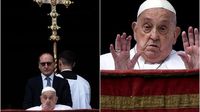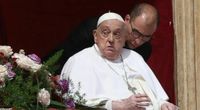Pope Francis, who passed away on April 21, 2025, at 7:35 AM, displayed alarming signs of impending death just hours before during his final public appearance on Easter Sunday. Infectivologist Matteo Bassetti analyzed the Pope's appearance during the Urbi et Orbi blessing on April 20, suggesting it indicated a dire prognosis. Bassetti described the Pope as having the "facies hippocratica," a term used to describe the sunken eyes, hollow cheeks, and gaunt face often seen in terminal patients.
In a post shared on social media, Bassetti remarked, "Look at that face. This is the face we doctors see 24-48 hours before death." He noted that the Pope's expression was indicative of significant suffering, likely linked to his ongoing health issues. The Pope had been battling a polymicrobial infection that severely compromised his respiratory system and overall health.
According to the official report from Andrea Arcangeli, the Director of Health and Hygiene of the Vatican City State, the immediate cause of death was a stroke, which was complicated by a coma and irreversible cardiocirculatory collapse. The report also detailed a history of acute respiratory failure due to bilateral pneumonia, arterial hypertension, and type 2 diabetes, all of which contributed to the Pope's fragile state.
Bassetti emphasized that the stroke itself might have been influenced by the severe infection that afflicted the Pope. He stated, "It seems evident that the triggering cause was a post-infectious complication." The physician further explained that fungal infections can lead to vascular changes in the brain, potentially causing fragile collateral circulation that could rupture, resulting in a stroke.
In the hours leading up to his death, the Pope woke up at 6 AM on Easter Monday but soon fell ill, suffering a sudden stroke that led to his demise less than two hours later. Bassetti's observations of the Pope's physical state during the Easter blessing raised concerns among the faithful, as many noted the visible signs of distress on his face.
The "facies hippocratica" is not merely a sign of fatigue but a clinical indicator of severe systemic distress. It has been recognized since the time of Hippocrates, who first described the phenomenon in his writings. This condition can manifest in various severe medical situations, including multi-organ failure and advanced sepsis.
In his analysis, Bassetti pointed out that the Pope's appearance was not just a reflection of tiredness but rather a clear signal of a deteriorating health condition. The Pope's long-standing health issues, including high blood pressure and diabetes, made him particularly vulnerable to complications from infections.
Despite the official cause of death being a stroke, Bassetti's insights suggest a more complex interplay of health factors at work. He argued that while the stroke was the final event, it was likely a consequence of the severe respiratory failure and infection that had already taken hold of the Pope's body.
The day's events unfolded rapidly, with the Pope's final public appearance on Easter Sunday being a poignant moment for many. He delivered the traditional blessing, appearing frail yet determined to fulfill his duties to the faithful. However, the signs of his illness were unmistakable, as he struggled with his health in the days leading up to his death.
In the wake of his passing, the world mourned the loss of a leader who had been a beacon of hope and compassion. Pope Francis's pontificate was marked by his commitment to social justice, interfaith dialogue, and addressing issues such as climate change and poverty. His death is seen as a significant moment in the history of the Catholic Church, with many reflecting on his legacy and the impact he had on millions around the globe.
As the Church prepares for the transition following the Pope's death, discussions are already underway regarding the future leadership and direction of the Vatican. The circumstances surrounding his health and eventual passing have reignited conversations about the challenges faced by aging leaders and the importance of addressing health issues proactively.
In conclusion, the passing of Pope Francis serves as a reminder of the fragility of life and the impact of health on leadership. His final moments, marked by the signs of the "facies hippocratica," reveal the profound struggles he faced in the last days of his life, underscoring the importance of compassion and understanding in the face of suffering.






